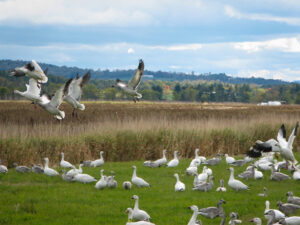
- This event has passed.
Spring Snow Goose Hunting (Conservation Order) Season Closes
April 23, 2023
Vermont has a special spring snow goose hunting opportunity that will be held from March 11 through April 23.
Since 2009, the U.S. Fish and Wildlife Service has annually issued a “Conservation Order” to allow the reduction of the population of migrating greater and lesser snow geese as well as Ross’ geese. The numbers of these geese have grown so high that they are destroying habitat for themselves and other species.
Eight states in the Atlantic Flyway (Delaware, Maryland, New Jersey, New York, North Carolina, Pennsylvania, Virginia, and Vermont) will hold a similar Spring Snow Goose Conservation Order in 2023.
The Vermont 2023 Spring Snow Goose Conservation Order will occur statewide. The daily bag limit is 15 snow geese, and there is no possession limit. Waterfowl hunting regulations in effect last fall will apply during the 2023 Spring Snow Goose Conservation Order with the exception that unplugged shotguns and electronic calls may be used and shooting hours will be extended until one half hour after sunset.
A 2023 Spring Snow Goose Harvest Permit is required and is available at no charge on the Vermont Fish and Wildlife Department’s website under “Hunt” and “Waterfowl.”
Hunters will need a 2023 Vermont hunting license (residents $28, nonresident small game $50), a 2023 Harvest Information Program (HIP) number, a 2022 federal migratory hunting stamp ($25), and a 2023 Vermont migratory waterfowl stamp ($7.50).
Hunters can register with the Harvest Information Program by going to Vermont Fish and Wildlife’s website or by calling toll free 1-877-306-7091.
Hunters who obtain a permit will be required to complete an online survey prior to May 16, 2023, whether they hunted or not.
“The breeding population of greater snow geese has grown from approximately 50,000 birds in the mid-1960s to 714,000 birds today,” said Andrew Bouton, Vermont’s waterfowl project leader. “This increase has resulted in damage to agricultural crops and marsh vegetation in staging and wintering areas from Quebec to North Carolina. Hunting pressure to date has aided in reducing the population from its high point of just over one million birds during the period of 2000-2010. The Atlantic Flyway has established a goal of 500,000 greater snow geese to bring populations in balance with their habitat and reduce crop depredation.”
During spring migration, snow geese typically move through the Champlain Valley in late March and early April. They usually pass through Vermont quickly in route to their spring staging areas along the St. Lawrence River Valley. They remain there for about a month before moving on to their nesting areas in the Eastern Canadian Arctic.

